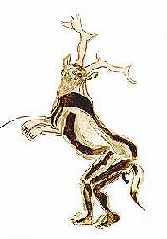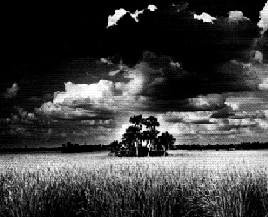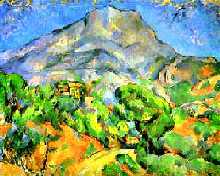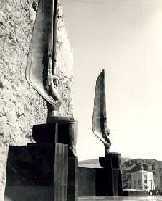like Nijinsky: "The new ballet master calculated that each boy would leap according to his own limitations and so the many-headed flock of fauns would end up scattered all over the stage. And that's how it was. There was just one boy who jumped, suddenly broke loose from the center, seemed to suspect himself above everyone else, and then landed on the floor far in front of the rest." V. Krasovskaya, Nijinsky. New York, 1979. p.32. "(Michel) Fokine always remembered this transformation of a gangling schoolboy into a half-man-half-beast rejoicing unconsciously in his nature." Ibid. p.33. "In the dream world we do not fly because we have wings; rather, we think we have wings because we have flown. Wings are a consequence. The principle of oneinic flight goes deeper." G. Bachelerd, Air & Dreams. Dallas, 1988.
gravity: "To the eye of primeval man, animals that to us appear to be standing on their heads, do not appear inverted to him because they exist, as it were, in space free from the forces of gravity." S. Giedion, "Space Conception in Prehistoric Art." In, E. Carpenter and M. McLuhan, Editors, Explorations In Communication. Boston, MA., 1968. p.87.
shamans: "A number of human figures, shown singly or in groups have been interpreted as dancers. The painted figure looming over the sanctuary in Trois Frères, the famous 'sorcerer' with wide-staring eyes and reindeer anthers, is in a low crouching position and could well be imitating the movements of some animal as part of a dance sequence. His posture reminded (Henri) Breuil of a 'cakewalk dance.' There is a similar male figure not far away in the same cave, on the panels that include more than seventy animals. He is surrounded by horses and horned bison, wears a pair of long curving bison horns, and seems to be executing some sort of high-stepping dance." J.E. Pfieffer, The Creative Explosion. New York, 1982.
lung-gom-pa: "By that time he had nearly reached us; I could clearly see his perfectly calm impassive face and wide-open eyes with their gaze fixed on some invisible far distant object situated somewhere high up in space. The man did not run. He seemed to lift himself from the ground, proceeding by leaps. It look as if he had been endowed with the elasticity of a ball and rebounded each time his feet touched the ground." A. David-Neel, Magic and Mystery in Tibet. New Hyde Park, NY., 1965.
The dancing foot, the sound of the tinkling bells,
The songs that are sung and the varying steps,
The form assumed by our Dancing Gurupara--
Find out these within yourself, then shall your fetters
fall away.
Tirumular, "Tirukuttu Darshana (Vision of the Sacred Dancer)."stamp: The direction of the dance is how a culture expresses its movement toward its god. In the West, it is primarily upward, one is lifted, as in ballet, and with spiritual exercises. In the East, in Sumo wrestling and Butoh dance, for example, one is grounded, stamping the earth; or, in the case of many meditation practices, sitting on it. This is also true in much of Amerindian culture.
ancient fires: "Soviet archeologists digging at a site on a tributary of the Dnieper River northeast of Kiev unearthed a set of mammoth bones painted red which they believe served as percussion instruments: hip-bone xylophone, skull and shoulderblade drums, and jawbone castanets." J. E. Pfieffer, The Creative Explosion. New York, 1982. p.180.
: N.K. Sanders, Prehistoric Art in Europe. Baltimore, MD., 1968. p.72.
in their view: D.J. Siegal, The Developing Mind. New York, 1999. p.303.
the smile: Smiling is a motor action...so it's a little surprising that its onset is not attributable to maturation of the motor cortex. The reason is that smiling is not voluntary. Although you can willfully concoct you your face into a smile, this kind of 'polite' smile uses only the muscles of your mouth. Genuine smiles, by contract,, also involve a specific muscle that surrounds the eye, the orbicularis oculi, and movement of this muscle is entirely involuntary. The orbicularis oculi is controlled solely by the limbic system..." L. Eliot, What's Going On In There? New York, 1999. p.302. "A spontaneous smile is produced by the basal ganglia, clusters of cells found between the brain's higher cortex (where thinking and planning take place) and the evolutionary older thalamus." V.S. Ramachandran and S. Blankeslee, Phantoms in The Brain. New York, 1998. p.13.
chances are: "patients suffering from disorders of the basal ganglia...are no longer able to perform the habit of an appropriate sequence of movement, or of recognizing the next item in a sequence that had been shown to them over and over again and normally would have been implicitly remembered." S.A. Greenfield, The Human Brain. New York, 1997. p.135.
a collection: http://thalamus.wustl.edu/course/cerebell.html
vague myths: "For when the human mind is confronted with realms which transcend the bounds of experience, the mythic imagination goes to work, populating the dark hinterlands of our maps with dragons and chimeras. The narratives of science, according, almost always conceal mythic patterns, if you look closely enough." J.D. Ebert, Twilight of the Clockwork God. Tulsa, OK., 1999. p.27.
Neanderthal People: "The man had been buried in a grave hollowed out among the rocks and covered over with earth from the living floor of the cave. Detailed and precise pollen analysis of the grave soil and surrounding levels showed that the body had been laid to rest in a bed of brightly-coloured flowers, probably woven into wreaths with a pine-like shrub." (The Shamidar Cave, 600 miles east of Mount Carmel, northern Iraq was excavated by Ralph Soolecki, who estimates initial occupation close to 100,000 BP. M. Shackley, Neanderthal Man, London, 1980. pp. 92-3.
mystery of death: "According to many of my (Hindu) informants (death) occurs not at the cession of physiological functioning but at the rite of Kapal Kriya, which is performed mid-way through the cremation, and at which the chief mourner releases the 'vital breath' from the charred corpse of the deceased by cracking open his skull with a stone." J. Parey, "Sacrificial Death and the Necrophagous Ascetic." In, M. Black and J. Parry, Editors., Death and the Regeneration of Life. Cambridge, England, 1982. p.79. "In the case of a man of great spiritual force a kind of spontaneous combustion cracks open his skull to release the vital breath; while the vital breath of one who dies a bad death emerges through his anus in the form of excrement, through his mouth as vomit, or through one of his other orifices." Ibid. p.82.
Zapotec: For example, among the Post-Classic Zapotec, it was common to remove the femur of your father or grandfather from his grave and use it as a scepter, if you were a ruler. (I believe these were "worked," too.) There are also preserved artifacts from the Zapotec/Mixtec of human and jaguar bones carved with designs (on display in the Oaxaca Regional Museum, Oaxaca, Mexico).@ -Billie J. A. Follensbee, bfollens@deans.umd.edu
cult of relics: "It was decreed by the Second Council of Nicaea in 787 that no church should be dedicated without the placing of relics. This necessitated the fabrication of a relic if no original article was to be had. The papal decree that relics had the power of reproducing themselves did much to relieve the situation, it also accounts for their multiplicity of the limbs of the same saint to be found." W. Bonser, "The Cult of Relics in the Middle Ages." Folklore. Vol. 73 Winter 1962. p.236.
In the Highlands: "At death, the flesh of the person is expected to rot, and in the past, prior to the influence of Christian missions, the skull of an important man and some of his limb bones might also to taken as relics and established in a peng manga ('head house'). In accordance with a structure of ideas which is common in the Highlands, flesh is thought of as associated with 'female' values, whereas bone is linked with 'maleness.' The enduring 'male' part was thus preserved and made a focus for continuing communication, while the flesh rotted back into the earth." A. Strathern, "Witchcraft, Greed, Cannibalism and Death: Some Related Themes from the New Guinea Highlands." In, M. Bloch and J. Parry, Editors, Death and the Regeneration of Life. Cambridge, England. 1982. pp117-18.
North Cameroon: Nigel Barley, "The Dowayo Dance of Death." In, S.C. Humphreys and H. King, Editors, Mortality and Immortality: The Anthropology and Archaeology of Death.
In China: In a related custom, "For many centuries the Cantonese have followed a system of double burial whereby the corpse is first buried in a coffin and left for approximately seven years. The bones are then exhumed and stored in a ceramic urn. Finally, when an auspicious location has been acquired, the urn is reburied in an elaborate, horseshoe-shaped tomb. The final stage many not occur until decades or even generations after death, depending on family circumstances. The bones begin to function for the benefit of descendants only after the final stage of the burial sequence has been completed." J.L. Watson. "Of Flesh and Bones: The Management of Death Pollution in Cantonese Society." In, M. Bloch and J. Parry, Editors, Death and the Regeneration of Life. Cambridge, England. 1982. p.155.
their ancestors: "Something new dawned in the history of the human species, Edmund Husserl wrote, when men in Athens, conversing with foreigners, began giving reasons for the ways of Athenians. Until then, to the questions of foreigners--Why do you think as you do, do as you do?--the answers had been: Because our fathers, who founded our clan, nation, city, have taught us to do thus. Because our gods have said this. The men called philosophers set out to give answers that those who did not share those ancestors, who did not have the totem gods of the Athenians, could accept." A. Lingis, Dangerous Emotions. Berkeley, 2000. p.86.
dark sunken: "The dark feminine principle, subconscious spontaneous life, is the main metaphor for Botoh (dance), its aesthetic core." S.H. Fraleigh, Dancing Into Darkness. Pittsburgh, PA., 1999. p.58.
Edith Piaf: Edith Piaf was born on 19th December 1915 under a gas light on the streets of Paris. Her real name was Edith Giovanna Gassion. Her father was an acrobat, performing the streets of Paris, her Mother a street singer who had no care for her new born child. Later called "Sparrow," she became of the greatest, and highest paid, singers of her time, with a worldwide audience. Piaf's life, like her songs, was filled with tragic love affairs, failed marriages, and drugs. She died, in debt, in 1963.gravity: "On the plane of stars, we use the word 'gravity' but we're really using the word 'gravity' to point to a fundamental power of attraction. And on the level of the human, we say 'fascination' or 'interest.' But once again, that's pointing to the same power of attraction, just in a different form." B. Swimme, "God and the Quantum Vacuum: A Conversation with Brian Swimme." In, J.D. Ebert, Twilight Of The Clockwork God. P. 37.
I'll live gently: S. Takahashi. From, "Wind." L. Stryk, Translator.
Everglades: "Everglades is a deceptive word. It has to be split. The second part comes from the old Anglo-Saxon glyde or glaed, meaning a bright, shining open space in the forest. And that fits. But the first part is tricky, for it promises an eternity of grass and shining water, together, without limit in time or space, as if they always were and always will be, world without end, never changing and forevermore." P.G. Mitchell, Everglades. San Francisco, CA., 1970. p.33.
the scientists: G. Johnson, "The Joy of Gravitons, Hyperspace, Branes and Brainstorms." The New Your Times. 4 April 2000. D10.
brane: A 3-dimensional bubble that floats inside a four-dimensional hyperspace.
islands: The basal ganglia do not have a laminar organization, but rather a patchwork of islands which can be distinguished by developmental and chemical markers." P.S. Churchland and T.J. Sejnowski, The Computational Brain. Cambridge, MA., 1993. p.35.
sugar barons: See, P. Roberts, "The Sweet Hereafter." Harper's Magazine (November 1999). pp.54-68.
according to: M. Wertheim, The Pearly Gates of Cyberspace. New York, 1999. p.173.
nature won't: D. Quammen, "Planet of Weeds." Harper's Magazine. (October 1998). pp.57-69.
Abiquiu: The meaning of the word ranges from Pueblo P'efu (a large grove), to the hooting of an owl, or simply ruins. The settlement goes back to the 18th Century.
blinding Hermes: "Man's central striving is to return to his essence, to find his way back to his luminous body or self, and his homeward road, as Novalis calls it, is the road of gnosis, leading man to know God and to be known by that God, of whom our luminous self remains a part. This is made clear by the prayer to Hermes...'All our inwardness save, O life, illuminate, O light, spiritualize, O God.'" M. Pulver, "The Experience of Light in the Gospel of St. John, in the 'Corpus hermeticum,' in Gnosticism, and in the Eastern Church." In, J. Campbell, Editor, Papers From The Eranos Yearbooks. Volume 4, Spiritual Disciplines. Princeton, NJ., 1985. p. 246.
the body: D.B. Morris, The Culture of Pain. Berkeley, 1991. p.269.
no general agreement: J. Campbell, Historical Atlas of World Mythology. Vol. 1. The Way of the Animal Powers. Part I, "Mythologies of The Primitive Hunters and Gatherers." New York, 1988.
morada: The Penitente Brotherhood is a lay religious order which was introduced into New Mexico when priests were in short supply. The Penitentes undertake penance that mimics Christ's Passion, reaching its climax on Good Friday. The morada, or chapel, usually contains bultos, or statues, and a small death cart, used in processions, in which is seated ‘La Muerte,’ a figure of Death dressed as a woman.
celebration: R.E. Ryan, The Strong Eye of Shamanism. Rochester, VT., 1999. p.230.
Mont Sainte-Victorie: "In Delphi, once thought to be the center of the world, the grass in the stadium was all aflutter with butterflies, which the poet Christian Wagner took to be 'the redeemed thoughts of the holy dead.' But in the face of Mont Sainte-Victorie, when I stood amid the color of the open country between Aix and Le Tholonet, I thought: Isn't the spot where a great artist worked the center of the world--rather than places like Delphi?" P. Handke, Slow Homecoming. New York, 1985. p.160.
nameless: "The early chapters of the Book of Genesis amount to a catalogue of arrangements that didn't work out (sinlessness, immortality, the zero-hour work week). But one reality that survives unaltered from the moment of creation through the expulsion from Eden and up on to the present day is the authority vested in human beings to endow everything on the planet with a name..." C. Murphy, "Nominal Authority." The Atlantic Monthly. February 2000. p.16.
Death Is: Epitaph on the gravestone of Lindolfo Gonzales, Oct 12, 1951-Sept 11,1981.
animal tracks: "There is an animal on the ground with it's guts ripped open - it's blood marks a larger circle around it - delineating its 'personal' space (or spirit space) - I see (and feel) the wetness of its blood on the ground and bushes and know that the blood is becoming crust which the wind will soon blow away. A lion is sitting next to the dead animal - blood drips off the hair bristles around its mouth and I can feel in my guts the fullness of the lion's stomach and the dead animals lack of guts. Nothing is happening. The dream hit me complete in the instant. I knew every (very sharp and clear) detail complete (right down to the smell)- and the only time there was was the time that it took me to feel some very strong emotions. I woke up and started to think about all this new insight. I wondered what you would say from inside your skull house." ["Dream by Kevin Campbell. Received via e-mail, September 23, 1998.]
stale and dung: "The Nuer (of the southern Sudan) wash their hands and faces in the urine of cattle, especially when cows urinate during milking, drink their milk and blood, and sleep on their hides by the side of the smoldering dung. They cover their bodies, dress their hair, and clean their teeth with the ashes of cattle dung, and eat their food with spoons made from their horns..." E.E. Prichard, Nuer Religion, Oxford, 1986. pp.36-7.
loop: "The results from PET studies imply that some brain areas are used to plan the output (and are active only when one is speaking) and some are used to produce the necessary movements. Considerable details are now known about the neuroanatomical underpinnings of these subsystems. Two distinct circuits, which are organized into loops, are involved in producing the movements critical for verbal output, the first of which actually controls the motor output. This loop includes cortical areas (such as M1 and Broca's area) involved in controlling the mouth, lips, tongue, jaw and vocal apparatus, and various subcortical structures, notably in the basal ganglia (the putamen and parts of the globus pallidus; plus the substantia nigra and the ventral lateral thalamic nucleus). And it appears to us that the second system is 'wired' in a way that allows it to direct the movement execution subsystem so that the different organs work in concert to produce a specific sound. This loop runs from the supplementary motor area (SMA) to parts of the basal ganglia (the striatum and the globus pallidus, via the subcallosal fasciculus) and then back from the thalamus (ventrolateral nuclei) to the motor cortex." S.M. Kosslyn and O. Koenig, Wet Mind. New York, 1992. p.252.
containing the seeds: R.E. Ryan, The Strong Eye of Shamanism. Rochester, VT., 1999. p.105
The writer: M. Taussig, Defacement. Stanford, CA., 1999. p.2.
smiling: "Animal experiments have shown that certain of the basal ganglia are responsible for a particular class of motor behaviors: stereotyped displays that are used to communicate social status, competitive challenge, alliance, and courtship to fellow members of the species. Smiling serves a similar function in humans--as a universal sign of greeting--and is probably triggered by activity in these same basal ganglia." L. Eliot, What's Going On In There? New York, 1999. pp.301-2.
When it comes: J. Horgan, The Undiscovered Mind. New York, 1999. p.261.
pictures: By Max Kozloff, "Crossed Purposes." A joint show with Joyce Kozloff, at the Albuquerque Museum, January 2000. "While Joyce (Kozloff) studies and explores )the intimate connection between humanity and its physical surroundings) through reading and careful observation of the totality of public spaces, from museums and other buildings to marketplaces full of local products, Max directs his attention to the microcosm of individuals interacting with (or displaced from) other people and their surroundings..." T. Behrens, Polk Museum of Art.
is a name: Leslie Crespin. In the early 1980s, she and I almost had a two-person show (her paintings and my sculptures) at an Albuquerque gallery. I don't remember exactly why it fell through, but it was probably because of my insistent on a mood being created in the gallery.
unmappable field: Refers to Joyce Kozloff's cartographic strategy . (See statement, "While Joyce...", above.)
a Traveler: "The legend of the Traveler appears in every civilization, perpetually assuming new forms, afflictions, powers, and symbols. Through every age he walks in utter solitude toward penance and redemption." E.S. Connell, Jr., Notes From A Bottle Found On The Beach At Carmel. New York, 1962. pp.61-2.
Rio Puerco: "In the early morning of July l6, 1979--fourteen weeks after the accident at Three Mile Island...the dam at Church Rock burst, sending eleven hundred tons of radioactive mill wastes and ninety million gallons of contaminated liquid pouring (down the Rio Puerco) toward Arizona." H. Wasserman & N. Soloman, Killing Our Own. New York, 1982.
radiant past: The Jackpile-Paguate mine, owned by Anaconda Minerals Corp., is located on the Laguna Pueblo, 40 miles west of Albuquerque. For 29 years this was the world's largest open pit uranium mine, with almost 25 million tons of ore extracted from 2656 acres. Some 2000 acres of land covered by tailings and ore storage piles are currently in the process of reclamation.
Hades: "I arrive in Hades, but it's not a land of terrifying fire and molten rock as expected, instead this looks like the ordinary world--blue sky, green grass, streets lined with office buildings, trees, houses, stores. The ordinary world, of ordinary things, I muse, shaking my head in wonder." D.R. Dahl, The Blue Deer and Other Dreamtales. Santa Barbara, CA., 1998. p.96.
is told: W. Dosick, Dancing With God. San Francisco, 1997. p.63
the basal ganglia: A. Parent, Comparative Neurobiology of the Basal Ganglia New York, 1986. p.235.
a superior type: S. Lonsdale, Animals and the Origins of Dance. p. 11.
Who was Walter Benjamin?: H. Muschamp, "The Passages of Paris and of Benjamin's Mind." "Music seems to have settled into these spaces only with their (the arcades of 19th Century Paris) decline, only as the orchestras themselves began to seem old-fashioned in comparison to the new mechanical music. So that, in fact, these orchestras would just as soon have taken refuge there." W. Benjamin, The Arcades Project. Cambridge, MA., 1999. p.204.
Hoover Dam: Construction of Hoover Dam began in 1931, and completed in 1935, two years ahead of schedule, the last of its 17 generators added in 1961.
Imagination: Hoover Dam was the first man-made structure with a larger masonry mass of the Great Pyramid of Giza. Its object was to control the Colorado River, the cycles of drought and flood in the American southwest that incapacitated the growth of the agricultural, and provide hydroelectric power to Las Vegas and Southern California. Because of its remote site, roads and railroad lines first had to be built, then the Colorado was temporarily diverted into four tunnels.
Bravado: Before construction could begin, "high-scalers" removed loose rock from the eroded canyon walls. Swinging over a void with 44 lb. jackhammers, and sticks of dynamite, they worked their ropes though a maze of electrical lines, air hoses, and the risk of falling rocks and other objects. Such was the danger from falling object that the men improvised "hard-boiled hats" by coating cloth hats with coal tar, until the company finally contracted for commercially made hard hats.
Carve out: After the river was diverted, the canyon floor was dredged down to bedrock, and concrete began to be poured in rows and blocks through which refrigerated water was pumped, the pipes, too, later filled with concrete, 3,250,000 cu yd. plus another million in the appurtenant works, made from over 5 million barrels of Portland cement and 4.5 million cu. yds of aggregate.
a monument: In a competition to find a monument for the dam, Oskar Hansen's surrealistic thirty feet tall seated winged figures were chosen to adorn the site. Hansen also was responsible for a star map being set in the monument's floor, linking the moment the Hoover Dam was dedicated with such events as the building of the pyramids and the birth of Christ.
Seami: G. Snyder, "On the Path and Off the Trail." Antaeus. Autumn, 1989. p.231.
Does the basal ganglia have a connection with 'enlightenment,' the smooth movement through time and space? If one asks, "Who learned the steps of this dance," the ganglia would reply by dancing. This twisted knot, this yoga, this homeless soul buried deep in the mind.
Wall Street: "The lexicon of The Wall Street Journal and the business sections of Time and Newsweek turned out to bear a striking resemblance to Genesis, the Epistle to the Romans, and Saint Augustine's City of God. Behind descriptions of market reforms, monetary policy, and the convolutions of the Dow, I gradually made out the pieces of a grand narrative about the inner meaning of human history, why things had gone wrong, and how to put them right. Theologians call these myths of origin, legends of the fall, and doctrines of sin and redemption. But here they were again, and in only thin disguise: chronicles about the creation of wealth, the seductive temptations of status, captivity to faceless economic cycles, and, ultimately, salvation through the advent of free markets, with a small dose of ascetic belt tightening along the way, especially for the East Asian economies." H. Cox, "The Market As God: Living in the New Dispensation." Atlantic Monthly. (March 1999).
in the house of Brahma: A.K. Coomaraswamy, The Dance of Shiva. New York, 1957. p.78
suggest the points: R.E. Ryan, The Strong Eye of Shamanism. Rochester, VT., 1999. p.231
there is a delay: R. Ornstein, The Right Mind. New York, 1997. p. 150.
sintering zeroscape: "Shiva is a destroyer and loves the burning ground. But what does he destroy? Not merely the heavens and earth at the close of a world-cycle, but the fetters that bind each separate soul." A.K. Coomaraswamy, The Dance of Shiva. New York, 1957. p.73 (The burning ground is "the place where the ego is destroyed (signifying) the state where illusion and deeds are burnt away." Ibid.
on the road: "To get back on the road because the road was the only place where you knew where you were going." -John Kielty Bell
you might be: B. Chiarulli. bev@chert.pgh.pa.us
the Chidambaram: A.K. Coomaraswamy, The Dance of Shiva. New York, 1957. p.77.
need to exist: R. Martin, Matters Gray And White. New York, 1986. p.71.
it is perhaps: J. Highwater, Dance: Rituals of Experience. Toronto, Canada, 1992. p.27.
the first clear: Thomas Willis, Anatome, cvi. Accessit, Nervorum Deseripto et Usus. London, 1672.
new breed: In a talk at The 2000 International Conference on Science and Consciousness, held in Albuquerque, NM., Huston Smith, distinguished Professor of Religious Studies, spoke of being visited by a group of young men whom he called the "New Breed." Their interest was in publishing essays Smith had written over several decades on the religious use of entheogens ("non-addictive mind-altering substances that are approached seriously and reverently, thus separating them from 'the psychedelic sixties,' when recreational use of drugs took over..." I use "new breed" to refer to eco-anarchists, whose sometimes destructive, maybe needful, actions are aimed against the "rapacious consumer culture that destroys the environment, exalts material values, and pacifies the benighted population by filling their minds with corporate-sponsored sludge." D. Samuels, "Notes From Underground: Among the Radicals of the Pacific Northwest." Harper's Magazine. May 2000. p. 40.
Earth: Zen monk Dangai's "enlightenment poem." L. Stryk, Translator.




